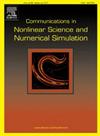Modeling and theoretical analysis of a stochastic novel vibro-impact galloping energy harvester with a U-shaped base
IF 3.8
2区 数学
Q1 MATHEMATICS, APPLIED
Communications in Nonlinear Science and Numerical Simulation
Pub Date : 2024-09-23
DOI:10.1016/j.cnsns.2024.108354
引用次数: 0
Abstract
This paper proposes a novel vibro-impact galloping energy harvester (VIGEH) with a U-shaped base. Different from classical galloping energy harvesters (GEHs), the design of the U-shaped base can avoid the damage of GEH during operation at high wind speeds by limiting the amplitude of the bluff body. The joint transition stationary probability density function (PDF) of the VIGEH is studied by further introducing the energy loss based on the stochastic averaging method. Afterward, various parameters of the VIGEH are analyzed and the results show that the smaller the distance between the rigid barriers, the higher the bump at the boundary of the joint PDF. The mean square voltage (MSV) and mean square displacement (MSD) of the VIGEH are also analyzed and the results show that the MSV and MSD are significantly enhanced when the galloping phenomenon occurs. In addition, the displacement and voltage of VIGEH and the ones of classical GEHs are compared, and the results show that the U-shaped base is effective in limiting the amplitude of the bluff body. When the input energy is the same, the output voltage of the VIGEH is higher due to the limitation of the rigid barriers which makes the bluff body vibrate at a faster frequency.
带有 U 形底座的随机新型振动冲击驰骋式能量收集器的建模和理论分析
本文提出了一种具有 U 形底座的新型振动冲击奔腾式能量收集器(VIGEH)。与传统的奔腾式能量收集器(GEHs)不同,U 形底座的设计可通过限制崖体的振幅来避免 GEH 在高风速运行时的损坏。通过进一步引入基于随机平均法的能量损失,研究了 VIGEH 的联合过渡静态概率密度函数(PDF)。随后,分析了 VIGEH 的各种参数,结果表明,刚性壁垒之间的距离越小,联合 PDF 边界处的凹凸越高。此外,还分析了 VIGEH 的均方电压(MSV)和均方位移(MSD),结果表明,当出现奔腾现象时,MSV 和 MSD 会显著增强。此外,还将 VIGEH 的位移和电压与经典 GEH 的位移和电压进行了比较,结果表明 U 形底座能有效限制崖体的振幅。在输入能量相同的情况下,VIGEH 的输出电压较高,这是因为刚性壁垒的限制使得崖体以更快的频率振动。
本文章由计算机程序翻译,如有差异,请以英文原文为准。
求助全文
约1分钟内获得全文
求助全文
来源期刊

Communications in Nonlinear Science and Numerical Simulation
MATHEMATICS, APPLIED-MATHEMATICS, INTERDISCIPLINARY APPLICATIONS
CiteScore
6.80
自引率
7.70%
发文量
378
审稿时长
78 days
期刊介绍:
The journal publishes original research findings on experimental observation, mathematical modeling, theoretical analysis and numerical simulation, for more accurate description, better prediction or novel application, of nonlinear phenomena in science and engineering. It offers a venue for researchers to make rapid exchange of ideas and techniques in nonlinear science and complexity.
The submission of manuscripts with cross-disciplinary approaches in nonlinear science and complexity is particularly encouraged.
Topics of interest:
Nonlinear differential or delay equations, Lie group analysis and asymptotic methods, Discontinuous systems, Fractals, Fractional calculus and dynamics, Nonlinear effects in quantum mechanics, Nonlinear stochastic processes, Experimental nonlinear science, Time-series and signal analysis, Computational methods and simulations in nonlinear science and engineering, Control of dynamical systems, Synchronization, Lyapunov analysis, High-dimensional chaos and turbulence, Chaos in Hamiltonian systems, Integrable systems and solitons, Collective behavior in many-body systems, Biological physics and networks, Nonlinear mechanical systems, Complex systems and complexity.
No length limitation for contributions is set, but only concisely written manuscripts are published. Brief papers are published on the basis of Rapid Communications. Discussions of previously published papers are welcome.
 求助内容:
求助内容: 应助结果提醒方式:
应助结果提醒方式:


